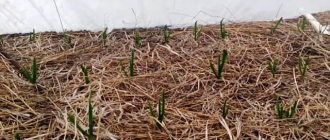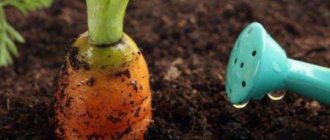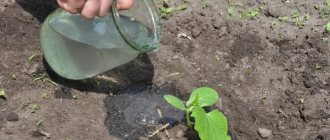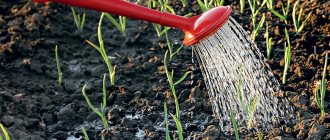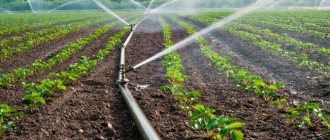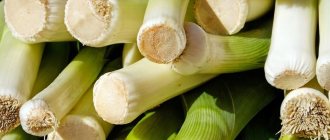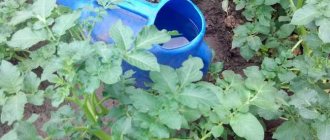General rules and regulations for watering onions
Onions are a stable and non-capricious crop, but for normal growth they need a suitable place for planting and an optimal watering regime.
Why water onions
The vegetative parts of a plant are on average 90% water. The size of the bulbs directly depends on the timeliness and amount of watering. To increase organic mass (both turnips and greens), onions require a lot of nutrition. Water provides plants with access to nutrients, which must arrive regularly and evenly.
Lack of moisture serves as a signal to stop the vegetative process and begin ripening of the bulbs.
When and how often
The moisture schedule is especially important at the stages of root formation, growth of leaf mass and the bulb itself.
After planting, the plant is actively watered. During this period, soil moisture is maintained within 70%. As soon as the bulbs reach the optimal varietal size, watering is reduced, and at the ripening stage it is stopped completely.
Important! Water for irrigation is taken warm. Do not use fresh well or tap water without prior infusion. The approximate norm is a bucket of liquid per 1 m2 of planting. This volume is adjusted based on precipitation and soil conditions.
When forcing onions, onions are moistened throughout the growing season.
How much water should I use?
Onions are usually watered quite abundantly. The exact amount of water used depends on the age of the plants. In any case, after watering, the bed should be saturated just enough so that everything, even the longest roots of the heads, “work.” Grown onions are usually watered at the rate of 10 liters per 1 m2 of bed. The soil under the plants should be wet by about 15-20 cm. For newly planted onions, you can use less water.
How to water correctly
Proper watering ensures constant, uniform soil moisture to the depth of the root system without the formation of a soil crust and stagnation of moisture. Methods for irrigating onions are gentle: sprinkling (for greens), between rows (for turnips), drip method.
In the open ground
Atmospheric and soil processes significantly affect the moisture schedule of vegetable beds. The need for the next watering is determined by checking the condition of the soil at a depth of several centimeters.
Attention! It is important to avoid getting any liquid on the bulbs to prevent them from rotting. Regulating the water pressure will prevent the soil from being washed away.
Irrigate vegetables in the morning or evening, not in hot weather. This will prevent burns on the leaves and rapid drying out of the soil. Warm water is used (+17…+18°C).
How to water onions. How often to water onions
In the greenhouse
Cultivation of onions in protected soil conditions is practiced year-round, mainly for forcing high-quality, abundant greenery (for feathers) . In addition to the usual onions, perennial varieties are used: leeks, spring onions, shallots and others.
Onions are planted more densely on feathers than on turnips. Water the crop from a watering can (sprinkling) with warm water as the soil dries. Usually they moisten less often than in the open air (in dry weather), since in greenhouses there is less ventilation and constant air humidity is maintained. In some greenhouses, onions are grown hydroponically.
Drip irrigation
Drip irrigation is the most effective method because:
- prevents the risks of waterlogging and soil erosion;
- significantly saves water resources, including reducing wastewater losses;
- allows dosed application of fertilizers;
- protects bulbs and feathers from burns and getting wet;
- maintains good soil indicators: mineral composition, looseness, etc.
Simultaneously with drip irrigation, fertigation is carried out (the crop is fed with liquid fertilizers).
Why is it important to water onions promptly and correctly?
Any plant needs moisture for good growth and normal development. Naturally, onions are no exception.
However, as in any business, you always need to maintain a balance. Therefore, under no circumstances should the onions be allowed to dry out due to lack of moisture, nor should the onion bed be turned into a swamp.
Note! Drought for onions is a signal that it is time to start the growing season, in other words, if you do not water the onions during their growth period, the bulbs simply will not gain mass and will remain small.
In addition, with insufficient watering during the growth period, the onion becomes more bitter.
And due to excess moisture, especially at the end of the growing season, if you continue to water the onions, the bulbs may simply become watery or begin to rot.
Drip irrigation
Of course, drip irrigation is ideal for watering all vegetables. Yes, onions are a relatively moisture-loving crop, but few people grow them on such a scale that it makes sense to use drip irrigation.
It's another matter if you grow onions for sale. However, this is a completely different story: here we are talking about amateur gardening.
Mulching
Instead of installing expensive drip irrigation, it is much easier to simply mulch your onion beds. Then, not only will you not have to water the onions often, but you will also practically get rid of procedures that are unloved by all summer residents, such as loosening and weeding.
If you grow without mulching, then after each watering it is advisable to loosen the soil and periodically weed (read about the nuances below), and the weeded grass can be left directly on the bed, it will later play the role of mulch.
Loosening and weeding
If you do not mulch the beds, you will need to periodically loosen and weed between the bulbs so that the plant receives enough oxygen necessary for development.
This measure is also necessary to ensure that a dense earthen crust does not form on the surface , which does not allow moisture and oxygen to flow evenly to the plants.
Periodically, loosening should be combined with weeding in order to eliminate fast-growing weeds .
Advice! When the bulbs reach medium size, you will need to gradually begin to rake away the soil from them, which will help increase their size and quickly ripen.
How to water at different stages of the growing season
The main secrets lie in varying watering rates at different stages of growth.
Before boarding
Before planting onions, the soil is spilled to a great depth with a double dose of liquid. It is advisable to use not just water, but a weak solution of potassium permanganate for disinfection.
With such abundant watering, the seedlings are planted the next day, when the soil reaches optimal moisture.
During early spring planting, when there is still a lot of natural moisture in the ground, pre-planting irrigation of the bed is not necessary.
Immediately after landing
After planting the seed, the soil is moistened to start the growing season. Even with autumn planting before winter, the seedlings must take root before retiring until spring.
At emergence and during the period of active growth
For onions, it is important that the feeding layer of soil at a depth of 10 cm remains evenly moistened.
Attention! The main thing in determining the need for watering is the dryness of the soil in the root layer. It is unacceptable to allow cracks to appear on the surface of the earth.
In the open air, the frequency of irrigation is determined depending on weather conditions (in the absence of rain - 1-2 times a week). The greenhouse is watered once every 10 days.
Bow on feather
The feathers are formed juicy if there are enough nutrients in the bulb. Water the crop abundantly throughout the entire period of green growth (taking into account the temperature conditions in the greenhouse). At temperatures around +15...+20°C, water moderately, once a week, on average 3 liters per 1 m2. With a significant increase in air temperature (more than +25°C), both the frequency of humidification (once every 4-5 days) and the volume of liquid (3-4 liters per 1 m2) are increased.
Before harvest
The intensity of watering is reduced when the peak of growth processes has passed. A signal for a decrease in moisture is the lodging of tops in 30–40% of plants. There is no need to stimulate the growth of new leaves. During this period, nutrients move from the green mass and concentrate in the bulb. When the feathers begin to actively turn yellow and dry out, stop watering completely.
How to water a large onion
The peculiarity of irrigating grown onions is associated with the need to protect the already formed heads from getting wet. Rain and root methods of moistening plantings are replaced by watering techniques between rows.
The soil in onion plantings is loosened superficially so as not to damage the roots lying in the top layer.
Methods for irrigating bulb beds
There are different ways to water plants, each with its own advantages and disadvantages. Experienced gardeners practice two main methods of moistening turnip beds: sprinkling and drip irrigation.
When sprinkling, the beds are watered from above (watering cans, garden sprinklers, hoses with nozzles are used). When watering from above, water flows down the leaves and is gradually absorbed into the soil. The advantages of the method: uniform distribution of water in the garden bed, the ability to adjust the pressure, saving liquid. Disadvantages: cannot be used in strong winds and sunny weather; heavy soils are not sufficiently moistened.
A drip irrigation system is laid throughout all the beds, which allows each plant to be watered individually. When arranging a system in onion beds, it is not necessary to make a branch for each bush, since the root system of the crop is not deep. It is enough to lay a hose with holes (hole spacing 8-10 cm) simply between the beds. Advantages of the method: water saving, uniform watering, does not stimulate weed growth, does not injure plants. Cons: high cost, system clogging, damage to drip tubes and tapes.
If a few onions are planted in a compact bed, then it is more convenient to water the plants with settled water from a garden watering can. When growing turnips for storage, it is recommended to make special furrows between the rows, which are filled with water from a hose. The grooves are dug at a distance of 10-15 cm from the bulbs.
Danger of overfilling
Despite the increased need for water on onions, at certain stages of growth it is important not to overdo it with hydration.
Attention! Excessive watering, especially on heavy soils, contributes to the development of rot in plants.
If there is excess moisture, the bushes are affected by powdery mildew, the bulbs crack, and wet areas appear on them. When the first signs of damage appear, stop irrigation.
When to stop watering
To ensure full ripening of the bulbs, watering is stopped 1-2 weeks before harvesting (approximately from the end of July to the beginning of August).
The time to collect green feathers comes when they reach the required length. In this case, they stop moistening the crop 2-3 days before the planned cutting, so that the feathers do not deteriorate from the liquid.
Danger
If you violate the watering regime, certain consequences may occur.
Overflow
When irrigating onions, keep in mind that oversaturation with water is a rather dangerous factor for bulbous crops. If the amount of water exceeds the norm, then the risk of the development of pathogenic bacteria increases significantly, which affects the duration of storage after harvest.
In addition, onions that are oversaturated with moisture rot - because of this, turnips become inedible, which negates all your efforts.
No moisture
Lack of moisture has one significant drawback - the plant can significantly slow down its growth or even stop developing. Therefore, the issue of timely and standardized watering is very important.
How and why to water onions with a nutrient mixture
Onions extract a large supply of nutrients from the soil, so fertilizing irrigation has a beneficial effect on them.
Salty water
Gardeners often fertilize onion plantings with salt water. It is affordable and economical, and salt not only contains elements beneficial to the crop, but also repels harmful insects (for example, onion flies).
To protect and feed the plants, water them with salt water no more than 3 times per season with an interval of 2-3 weeks. For the solution, take 200–300 g of salt per bucket of water. They pour at the root.
Important! Frequent watering with salt water deteriorates the quality of the soil and makes it salty. To neutralize this negative effect, at the end of the season, a double portion of organic fertilizers is applied to the beds.
A few hours after this treatment, the bed is irrigated with ordinary heated water.
Water with fertilizing
With good pre-planting fertilizer of the beds, the first root dressing is applied after 2-3 weeks. It is better to use organic fertilizer, since onion plants require nitrogen at first.
Until the end of July, when the plantings are in normal condition, complex fertilizers are added at the same frequency. If signs of starvation occur (pale feathers, slow development of bulbs), the composition and sequence of feedings are adjusted.
What mixtures are used for irrigation?
There may be situations where onion feathers turn yellow and dry out. Many gardeners believe that this is due to a lack of watering in hot weather and overwater their garden, which causes even more damage. The cause is most often the larvae of the onion fly, which eat the roots of the onion, which causes yellowing and wilting.
Watering the onions with salt water helps to cope with the problem. A working decoction is prepared from table salt and clean water. In one season, three waterings are carried out at intervals of 10 days:
- The first watering is carried out when the feathers grow 5-7 cm. The solution is made weak - 300 g of salt is dissolved in 10 liters of water. Half of this volume will be consumed per 1 sq.m. You need to water at the root.
- During the second watering, the amount of salt is increased to 400 g.
- During the third - up to 600 g.
If the first watering helped to cope with the onion fly, then the other two can also be left at 300 grams. After each watering with salt water, be sure to also water the onions with clean water.
Watering green onions in a greenhouse and open ground
The greenhouse is not exposed to precipitation, so the humidification schedule here is different from what is used outdoors.
In open ground, the crop is watered 1-2 times a week (depending on the weather). The soil is soaked to a depth of 10 cm, then the soil is carefully loosened between the rows, which ensures uniform soil moisture and prevents the formation of crust.
In a greenhouse, the watering schedule is clear, usually once every 10 days. Loosening the soil is replaced by mulching, since onion planting is denser in such conditions.
Why do onions need proper watering?
All plants need water for life processes. It is very important to provide vegetable crops with water evenly. Thanks to timely watering, the onion will be able to grow normally, form a bulb, and grow greenery.
At the same time, it is very important to maintain a balance when performing this care procedure! Excess moisture is also dangerous and harmful, as is lack and drying out of the soil.
Why can't you leave onions without watering? The fact is that drought for a given crop is a signal for the end of the growing season. Therefore, in the absence of watering during growth, the bulbs will not be able to gain mass and will grow small.
Complete and regular watering is very important in the first two to three months after planting onions in open ground. If there is insufficient watering, the bulbs will grow small, with low taste (it will be bitter).
And with excessive watering (especially at the end of the growing season), the bulbs will grow watery and will be stored worse. It is also possible for them to rot.
How to water seed onions
There are three methods of growing onions from seeds:
- a two-year cycle, in which seeds are obtained in the first year;
- growing bulbs from seeds in one year;
- seedling method.
To obtain healthy seedlings, the crop is irrigated 1-2 times a week as it grows. Stop watering at the stage of seed bulb maturation.
Before sowing in early spring, the bed is disinfected with hot water, the seeds are laid out in grooves, sprinkled with humus and covered with film to retain moisture. The film is removed only after germination. In the future, standard irrigation and fertilizing are carried out, as indicated earlier.
In the third method, seedlings are first grown from seeds at home. The crops are sprayed so as not to damage the tender sprouts. After planting in open ground, the seedlings are moistened daily for the first week for successful rooting. Subsequent care for onions is standard.
General rules
There are general rules when growing onions. After planting, the crop should be watered for two months in a row. As for frequency, it all depends on the weather. If the climatic conditions are determined by a rainy spring, then the onions do not need to be moistened. During periods of drought, the area planted with onions should be watered at least every 3 days.
Those who have recently started gardening are wondering whether it is worth watering onions when planting? As you know, the seed of the crop is sets (small annual onion heads), which are placed in the soil to a depth of 3 cm. It is worth saying that before planting, it is not necessary to water the soil. The heads can also be buried in dry soil to avoid damage to the roots. But after that, the bed planted with onions must be watered.
To determine the need to water onions, you should look at the soil, which should not be dry. While the green mass is growing, you need to ensure that the bed is always moist. In the second ten days of July, many onion varieties stop forming heads. In their growth, the next period begins - the accumulation of sucrose and various nutrients. Therefore, you do not need to water the onions often at this time. Otherwise, the heads will not be tasty and will not be stored for a long time. 20 days before harvest, soil moisture is completely stopped, even if the weather is dry. If this condition is not met, the onion will not last for several months.
Features of sprinkler irrigation systems
Sprinkler irrigation is effective when caring for lawns, in greenhouses and large areas of agricultural crops.
The installation itself is a system of pipes with nozzles spraying water - sprinklers. The sprinkler effect is created using dividers in the nozzles. This device has a more beneficial effect on plants even compared to drip irrigation.
Features of sprinkler humidification:
- optimal frequency and rate of watering in any weather;
- there is no risk of soil erosion or formation of soil crust;
- not only the root system is moistened, but also the ground layer of air;
- moisture and fertilizing mixtures are distributed evenly;
- the soil temperature decreases, which prevents it from drying out.
The cost of sprinkler irrigation is high, but in the southern regions of our country its use is economically beneficial.
The need for onions to water
The dominant atmospheric conditions of the area are considered the main regulators of soil moisture. If it rains constantly during the summer growing season, auxiliary watering of the onions may not be necessary. During prolonged hot weather, the crop level requires artificial humidification. In this article you will find out whether you still need to water the onions, or whether they grow well anyway.
Tips and tricks
To obtain a high-quality harvest, vegetable growers follow some subtleties of growing onions:
- To speed up ripening, in the second half of the growing season, the bulbs are unplanted or supported with partial roots being cut off.
- During prolonged rainy weather, film canopies are installed over the onion beds, protecting the crop from getting wet. This is especially true in August.
- Water the vegetable evenly, otherwise low-quality bulbs will form with alternating juicy and dry scales, which will adversely affect the shelf life of the crop.
What are the dangers of overflow?
Of course, you need to water the onions quite often. This garden crop should not be allowed to dry out under any circumstances. Otherwise, it will simply be impossible to get a good harvest. But at the same time, this plant should not be allowed to overflow under any circumstances. If there is a swamp in the onion bed, it will quickly begin to rot.
In addition, excess moisture will create favorable conditions in the soil for the development of various pathogenic microorganisms. For example, with excessive watering, onions can easily develop powdery mildew. In this case, even if you manage to harvest some kind of crop, it is unlikely that you will be able to preserve the heads in winter. The onions will begin to rot from the roots within a couple of months.
In damp areas, this garden crop is best planted in slightly raised beds. It would also be a good idea to arrange drainage in the garden by digging ditches to drain water into a receiving well and laying perforated pipes in them. In this case, not only onions, but also other garden crops will produce much larger yields.
Gardeners who have been growing vegetable crops for a long time are advised not to allow onion beds to become waterlogged. High humidity negatively affects the growth of seedlings and provokes the appearance of the following diseases:
- Mold rot. If you do not stop irrigating the onions before harvesting, traces of rotting will appear on the fruits. At first they will be invisible, but gradually the surface of the scales will begin to darken and turn black.
- Cervical rot. This is a common disease that occurs during crop storage. Due to neck rot, the tissues of the bulbs and leaves become softer. Gradually, the affected fruits darken and begin to emit an unpleasant aroma.
- Downy mildew. Pathology develops due to rainy weather or improper watering. Sick seedlings become covered with yellow spots and gradually dry out.
How often to water onions depending on the variety and weather
Watering during onion cultivation is one of the important procedures that determines the quality and quantity of the harvest. How often to water onions depends on the type, variety, cultivation and ripening conditions.
How often to water onions
Excess or lack of moisture received by a crop during growth can have negative consequences: the development of pathogenic bacteria, rotting or drying out of the bulb, poor growth, and the inability to preserve the harvest.
On the windowsill
Onion greens can be obtained at any time of the year by growing them on the windowsill.
The easiest way to force it is to place a large onion in a container of water. In such conditions, the turnip quickly grows roots and begins to produce feathers. It is enough to ensure that the bulb does not dry out.
Onions can be grown on the windowsill at any time
Due to limited space at home, the bulbs are placed tightly in a container with soil, without being completely buried. For rapid feather growth, light, heat and moisture are required. The average frequency of watering is once every 4-5 days. To avoid having to water the onions frequently and to prevent the greens from drying out, you need to avoid direct exposure to sunlight.
After landing
Bulbs will root faster if planted in moist soil. Moderate watering immediately after planting in the ground will ensure the soil adheres and create the level of moisture necessary for germination.
The first watering is carried out a week after planting or when the first greenery appears. Feathers indicate that the bulb has taken root and is growing. Subsequently, the frequency of irrigation depends on the condition of the soil, weather and onion variety.
On the beds
The influence of weather conditions makes it necessary to water onions in the beds more often than plants in the greenhouse. The average watering frequency is once a week. Water temperatures below +15 °C are undesirable so that the onion does not go into the arrow.
Onions in garden beds need to be watered more often than plants in a greenhouse.
The ground should be saturated with water to a depth of at least 15-20 cm. A stream of water from a hose can break up the soil and wash away planting material; a sprinkler or watering can provide more delicate watering. But getting moisture on the bulb or feather is undesirable, so the best option is a drip irrigation system. Thin hoses or tubes with holes every 8-10 cm are laid between the rows. This method saturates the soil with moisture evenly and non-aggressively.
The next day after each irrigation, the bed is loosened so that the soil is saturated with oxygen.
Winter onions
The awakening of winter onions occurs earlier than planting in the usual way in open ground, and at first it does not need additional watering. The appearance of the first feathers means the onset of the active phase of the growing season, and the buzzard is watered at the rate of 5-8 liters per 1 m2.
Subsequent care consists of weeding and fertilizing every 2-3 weeks. Fertilizers are applied to moist soil, so additional nutrition is combined with moderate watering.
Frequency of watering onions depending on variety
Onion varieties differ in taste and methods of consumption, as well as in periods of growth and ripening, resistance to diseases and pests, yield and shelf life. For successful cultivation, you need to know how often you can water onions of a particular variety.
Onion sets
The bed is spilled with water (boiling water is possible) to destroy fungi and additionally warm the soil. The seeds are covered with soil and carefully watered with warm water. It takes a long time for nigella to emerge, and during this period it is necessary to water the onion sets quite often, not allowing the crops to dry out.
Onion sets must be watered frequently, not allowing the crops to dry out.
The watering scheme for sprouted seeds does not differ from the usual for onions: 5 liters per 1m2 1-2 times a week during the period of growth and ripening. But given the tenderness and fragility of the growing seedlings, the soil is moistened extremely carefully.
A feather that falls down and turns yellow means the end of the growth period, at which point watering is stopped.
Onion on the head
Onions are grown in open ground. If the bed is not sufficiently moistened, it should be thoroughly watered on the eve of planting. Having placed the bulbs in the ground up to their shoulders, they are sprinkled with soil and watered with disinfecting and growth-stimulating solutions.
Moderate watering with settled water, preferably with a drip irrigation system, will help to avoid problems. You need to water onions on turnips more often at the rooting and germination stage (May): at least 5-8 liters of water per 1 m2 with an interval of 5 days.
Most often, onions on turnips need to be watered at the rooting and germination stage.
During the period of intensive growth (June and the first half of July), the frequency of watering is 1-2 times a week, 5 liters per 1m2
When arrows are found, they must be broken out, and the plants are watered to replenish the lack of moisture in the bulb and make it fill up. From this moment on, you no longer need to water the onion head so often; the interval between procedures is 12-14 days.
The application of water is stopped 2-3 weeks before harvest. Usually the signal for this is a lying onion feather.
To the greens
Feathers appear 7-10 days after planting in the soil; it is enough to ensure its constant moisture. Onions can be watered on greens once every 5 days at the rate of 10 liters per 1 square meter. m, using rain or settled well water.
Frequent watering does not harm such onions, but only increases the green mass.
Family varieties
Planting is done in moistened furrows; additional watering is not required, but to preserve moisture, you can sprinkle the bed with mulch. Until ripening, the soil is kept moist, following the basic rules for caring for onion crops.
Leek
The value of leek lies in the thick white basal part and powerful leaves, but it has practically no bulb. These features also determine the differences in caring for leeks.
The variety is very water-loving; such onions must be watered frequently and abundantly. For the same reason, loamy soils that retain moisture longer are more suitable for it.
For the first 2-3 days after planting seedlings, leeks are not watered into the soil. Subsequently, under normal weather conditions, up to 14 liters of water per 1 m2 are added at intervals of 4-5 days, and it is the soil that is watered, and not the plants themselves.
Batun
When growing batun seedlings in a greenhouse, containers with crops are sprayed almost daily with a spray bottle, preventing the soil from drying out, but also avoiding excess moisture.
The first watering is carried out 3-4 days after planting in open ground when using seedlings and 7 days after emergence when growing from bulbs.
To obtain lush greens, it is enough to provide moderate but regular watering. The soil should remain moist at a depth of 15-20 cm. In the absence of precipitation, irrigation is carried out a couple of times a week, in dry hot weather every other day. Watering does not stop until the end of the season, but with the onset of autumn the intervals are increased.
Bow exhibition
The variety is moisture-loving, so the soil should not be allowed to dry out. For growth and ripening, at least 1 liter of water is required for each bulb; watering is carried out at intervals of 3-4 days in normal weather, and daily in hot weather.
2 months after planting, the frequency of watering is reduced, and 1.5 - 2 weeks before harvesting it is stopped completely.
Frequency of watering onions depending on the weather
Caring for garden plants on a personal plot is adjusted in accordance with weather conditions.
Drip irrigation of onions
Novice gardeners sometimes wonder how often to water onions in rainy or dry weather.
In summer
In dry summer weather, watering onion crops is done 1-2 times a week. During periods of heavy rains, watering should be resumed no earlier than a week after the end. To avoid stagnation of water after heavy rainfall, the beds are equipped with drainage and drainage systems. Frequent but short-lived precipitation also reduces the plants' need for additional irrigation.
During the heat
Hot weather can cause the soil to dry out quickly. To prevent this, you have to water the onions often in hot weather, up to 2-3 times a week. This is especially true for water-loving varieties.
In hot weather, watering is done in the morning and evening.
Frequency of watering onions with water and fertilizers
Excess moisture can lead to premature yellowing of the feathers, the appearance of onion flies and other pests. Adding nitrogen will help cope with these phenomena. The liquid form of fertilizer is better absorbed and does not wash out longer. The main rule is to pre-moisten the soil with plain water and carry out the procedures in the morning and evening hours.
With urea
The solution concentrate is obtained from 1 tbsp. spoons of urea dissolved in 1 liter of warm water. It is diluted in 10 liters of clean water at a temperature not lower than room temperature and the beds are treated using the root watering method at the rate of 3 liters per 1 m2.
Urea treatment is carried out three times
The treatment is carried out three times. The first occurs at the beginning of the active growing season (end of May - June), subsequent ones are repeated at intervals of 2 weeks.
With salt
Treatment with saline solution can be carried out without waiting for damage to the crop. Repeating the procedure three times after 10 days guarantees results.
For preventive treatment, it is not necessary to change the concentration of the saline solution.
The first watering is carried out when the length of the feather reaches 5-7 cm. 300 g of table salt are diluted per 10 liters of water. For preventive treatment in subsequent waterings, the concentration of the saline solution does not need to be changed. If the plants are already affected, use 400 g of salt for the second feeding, and 600 g for the third. Treat 2 m2 with the resulting volume, watering at the root.
Watering with clean water after salt water is mandatory.
With ammonia water
This solution will enrich the plants with nitrogen and protect them from pests. To prepare 2 tbsp. spoons of 10% ammonia are dissolved in 10 liters of warm water. This amount is enough to water 2 m2 of beds. By increasing the ammonia content in the solution to 3 tbsp. spoons, the product can be sprayed on onions grown for turnips.
Ammonia water will enrich plants with nitrogen and protect against pests
The procedure is repeated 3 times every 10 days. After each treatment, you can additionally water the bed with clean water, this will improve the penetration of the ammonia solution into the soil.
Options for three seasonal fertilizers
Method 1
- a solution of water (10 l) and ammonia (3 tbsp.) - water 2 weeks after planting;
- water (10 l), ammonium nitrate (1 tbsp), salt (1 tbsp), potassium permanganate (a couple of crystals) - 3 weeks after the first feeding;
- water (10 l), superphosphate (2 tbsp.) - 4-5 weeks after the second feeding.
Method 2
- water (10 l), Vegeta product (2 tbsp), urea (1 tbsp) - water for 15 days after planting;
- water (10 l), Agricola 2 product (1 tbsp.);
- water (10 l), Effekton-O product (2 tbsp.).
Method 3
- Soak bread crumb (500 g) with water (10 l), add fresh cut grass (500 g) and fresh yeast (5 small packets), add after 2 days of settling ;
- water (10 l), nitrophoska (2 tbsp.);
- Pour boiling water (10 l) over wood ash (250 g) and leave for 2-3 days.
How to properly water onions on feathers at home
Bulbs are planted in the soil in different ways, but regardless of the planting method, the influx of clean water is organized according to a certain pattern.
Although onion crops are unpretentious in care, the juiciness of the stems depends on soil moisture. Dry green arrows will taste bitter and the bulbs will become unusable if the soil dries out. The bulbs are arranged in one row at a short distance from each other, so fertilizing the soil is quite easy. Saving space does not harm the feathers and the greens remain juicy for a long period.
Calculation of planting material is made: 1 sq. m is allocated for 10 kg of bulbs. m of soil. The ambient temperature is also important. The optimal temperature in a greenhouse or outside is 22°C. It is recommended to water the plant 3-5 times a month at equal intervals (breaks). After 2 weeks, a constant light regime is established in the greenhouse, accelerating the growth of green feathers. In the dark, arrows quickly turn yellow and lose their juices.
Every housewife can grow onions all year round at home, even in an apartment. For these purposes you will need:
- any convenient container;
- material for filling the container (soil, gravel or sawdust);
- bulbs.
Subtleties of watering onions grown by feathers
Sometimes onions are planted to produce early greens. The peculiarity of watering such a bed is that the soil is moistened more often. In dry weather, it is recommended to water the plants 2-3 times a week. Water consumption is 8-9 liters per square meter of bed.
Regarding the duration of watering, gardeners recommend moistening the soil almost before the first cut of the feathers. To prevent the greens from acquiring a watery state and to be stored longer, stop watering the beds 4-5 days before cutting.
If you want to get an autumn harvest of greens, the seedlings are sown in cold soil and watered abundantly. In order for the plant to take root and the leaves to grow, the soil must be constantly moist. We must not forget about low temperatures, so the beds are not abundantly flooded.
Adviсe
To prevent the onion from drying out and wilting, you need to familiarize yourself with the recommendations that will help you organize watering correctly:
- Irrigation should not be done in sunny weather. Watering under the scorching sun may cause burns on the foliage. Therefore, it is recommended to carry out the procedure in the evening or early morning.
- Do not moisten the soil daily. Everyday watering impairs the development of seedlings and contributes to fruit rotting.
- Do not allow changes in soil moisture. This negatively affects the growth of the vegetable.
- During drought, about 8-10 liters of liquid should be spent on each bush.
- The seed onion needs to be watered more often, since its development requires a lot of moisture.
- The soil should not be allowed to dry out, as this will cause the bulbs to ripen slowly.
Do I need to water before harvesting?
The approaching harvest of onions serves as a signal to stop each watering. If the sky is cloudy and rain is forecast, it is necessary to finish the convocation work or begin it after a downpour.
The harvest must be obtained from dry soil, otherwise drying will be significantly delayed and the threat of damage to vegetables by rotten microorganisms increases.
Not all dug up bulbs may be ripe; for this reason, it is recommended to subject the harvested crop to continuous sorting. It is preferable not to put onion bulbs that have not fully ripened for storage, but to use them for cooking. Select rotten and spoiled heads from healthy produce, as they can contaminate the onion.
Watering onions correctly is a single science that allows you not only to increase its yield, but also to cope with numerous crop pests. For example, using a saline solution for watering makes it possible to protect plants from onion flies, which activate yellowing of the leaves. The greasy solution does not affect the food quality and speed of ripening of the bulbs. It is prepared by mixing 200 g of sodium chloride (table salt) with 10 liters of water.
Feeding in autumn
The planning of the landing zone for the new season is carried out in the fall. The first step is to disinfect the soil . A day before the introduction of nutrition, watering is carried out with a special solution: water (10 l) with copper sulfate (15 g). This amount is enough to spray 5 m2.
The soil is disinfected with a solution of copper sulfate and water.
The most basic fertilizing for onions is carried out at the stage of preparing the site for beds - in the fall. To begin with, the soil is dug up and cleared of weeds and old roots . Humus or compost blanks are introduced for digging (4-6 kg are used per 1 m2).
To sow onion sets, the soil is enriched with dolomite flour (up to 150 grams per 1 m2), chalk or a special substrate that neutralizes the acidic environment. Wood ash and fluff lime are also used for these purposes. Yeast supplements should not be used.
On depleted soils, it is recommended to use potassium-phosphorus mixtures along with organic matter. They quickly restore the balance of nutritional components. If you plan to cultivate red and sweet varieties, then preference should be given to the potassium composition.
- superphosphate;
- fertika (granular complex with reduced nitrogen content);
- humic “Onion, garlic”;
- nitroammophoska;
- potassium sulfate.
Some varieties of onions are planted for the winter. It is necessary to enrich the soil with valuable microelements 2-4 weeks before planting . The fertilized soil needs to stand for a bit so that the active components have time to combine with the soil environment.
should not be used for autumn treatments:
By growing bulbous crops with regular complementary foods, you can reap a good harvest and get high-quality root crops with excellent taste and a long shelf life.


